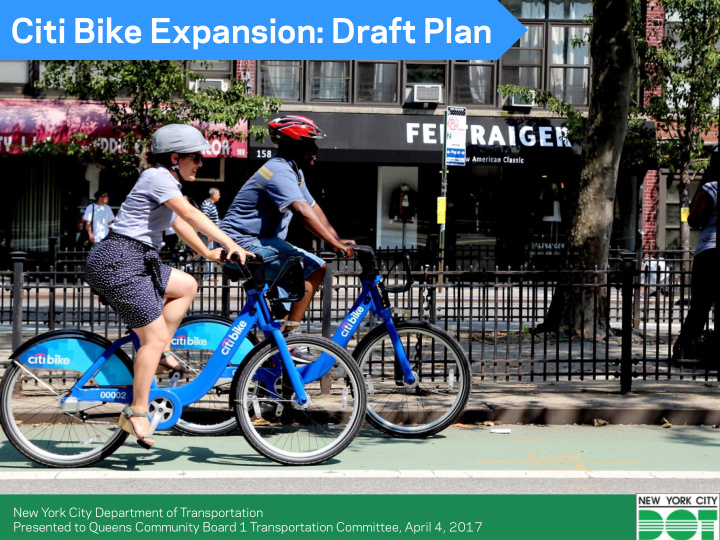



Citi Bike Expansion: Draft Plan New York City Department of Transportation Presented to Queens Community Board 1 Transportation Committee, April 4, 2017
What is Citi Bike? • Citi Bike is New York City’s bike share system • A network of bicycle rental stations intended for point-to-point transportation • Convenient for trips that are too far to walk, but too short for a taxi or the subway • System operates 24/7 • Public-private partnership • No city funds used
Strong Safety Record • Only one reported crash for every 160k trips • A 2014 CUNY Hunter study identified Citi Bike riders exhibited safer riding behavior than other cyclists • A 2016 Report from Mineta Transportation Institution found that Bike Share riders have lower rates of crashes than other cyclists • • • Source: NYCBS, as of October 2015
The Bike
Safe Cycling Promotion DOT promotes cycling safety with: • Helmet fittings • Light and bell giveaways • Safety awareness classes • Commercial cyclist workshops
Safe Cycling Promotion Citi Bike/Motivate promotes cycling safety with: • Safety ambassadors • Free Street Skills classes
Citi Bike Today • Growing to 12,000 bikes and approximately 750 stations by end of 2017 • Improved bicycle rebalancing, cleaning and maintenance • Interoperable with regional Jersey City system • Annual membership price $14.95/month with annual contract or $163 • NYCHA & CDC memberships $5/month with annual contract
Phase 2 Expansion Phase 2 • Currently, the system has: Expansion • 10,000 bicycles • 610 stations • By end of 2017, total size of Citi Bike system will be: • 12,000 bikes • 750 stations Current Service Area • Phase 2 sets stage for future expansion in any direction Phase 2 Expansion
High Ridership Trips Per Month (Millions) Average trip 2 duration is under 15 1 minutes 0 40,000,000 + Total trips 88% of trips 1,990,000 + are taken by Memberships sold annual 122,000 + Active annual members members 69,000 + Trips on busiest days 7.0 + Trips per bike on busiest days Data: NYCDOT (as of April 2017)
Planning and Outreach • Extensive participatory planning and outreach campaign conducted to select station locations in CB1 • In this area, outreach campaign has included: ‒ More than 18 meetings and events with CB1, elected officials, area institutions, BIDs, and other community organizations ‒ Public community planning workshops in October and November 2016
Creating a Plan Map presented at community planning workshops in October and November 2016 685 potential sites shown Participants asked to use red and green stickers and comment forms to indicate opinion on specific sites
Creating a Plan Potential sites are shown here by intensity of stakeholder preference Darker shade indicates greater preference Inputs include: • Community feedback • Concentration of support clicks from public web portal • Motivate operational considerations
Creating a Plan Where possible, less preferred sites were removed from consideration
Creating a Plan Community preference and network considerations were combined to create a draft plan 59 sites needed for CB 1 Draft Plan
Typical Station Locations STATIONS IN ROADBED Stations are typically located in the parking lane of the street, or on sidewalks that are wide enough to allow pedestrian flow 11
Typical Station Locations STATIONS ON SIDEWALK Stations are typically located in the parking lane of the street, or on sidewalks that are wide enough to allow pedestrian flow ALONG PARK VERGE ALONG BUILDING LINE ALONG CURB LINE
Questions? Thank You nyc.gov/bikeshare www.citibikenyc.com
Recommend
More recommend